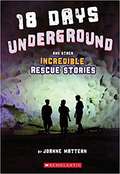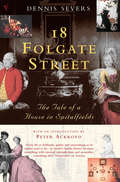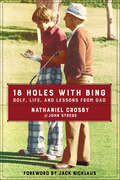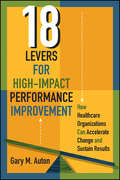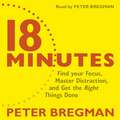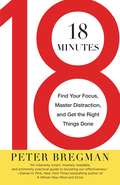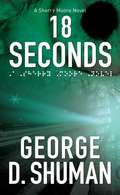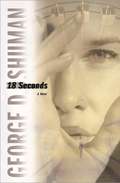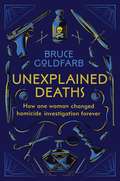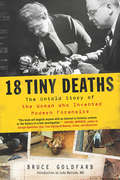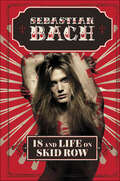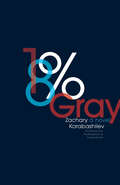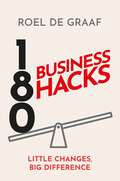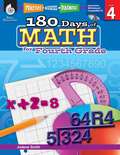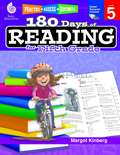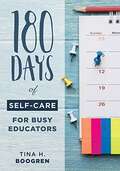- Table View
- List View
18 Best Stories by Edgar Allan Poe
by Edgar Allan Poe Chandler Borssard Vincent PriceA chilling compilation of some of Edgar Allen Poe's best-loved stories, edited by Vincent Price and Chandler Brossard and with an introduction by Vincent Price, including: The Black Cat - The Fall of the House of Usher - The Masque of the Red Death - The Facts in the Case of M. Valdemar - The Premature Burial - Ms. Found in a Bottle - A Tale of the Ragged Mountains - The Sphinx - The Murders in the Rue Morgue - The Tell-Tale Heart - The Gold-Bug - The System of Dr. Tarr and Prof. Fether - The Man That Was Used Up - The Balloon Hoax - A Descent Into the Maelstrom - The Purloined Letter - The Pit and The Pendulum - The Cask of Amontillado
18 Days
by Sara Fiore Giulia MastrantoniThere are moments when life slows down. We have to wait and we are both scared and hopeful. That’s how I spent the first 18 days of my daughter’s life. She was born and she was moved from one hospital to another in order to get the chance to survive. It was not easy, nor foreseenable. We all needed to be strong. That’s what happened and I am glad she doesn’t remember any of it.
18 Days Underground: And Other Incredible Rescue Stories
by Joanne MatternTen gripping true-rescue stories are presented with an emphasis on the everyday heroes that stepped up to help others when then needed it the most.
18 Folgate Street: The Life of a House in Spitalfields
by Dennis SeversGrowing up in California, Dennis Severs fell in love with the England he saw in old black and white movies. At seventeen he came to London, looking for a home with a heart. In 1979 he found one, a run-down silk-weaver's house in Spitalfields, and over the next twenty years he transformed it into an enchanted time-capsule, transporting us back to the eighteenth century. From cellar to roof, he filled 18 Folgate Street with original objects and furniture, found in the local markets, lit by candles and chandeliers. More than that, he invented a family to live here, the Jervis family, Huguenot weavers who fled persecution in France in 1688, and bought the house in 1724. Sounds and scents bring their world to life, always just out of sight - floorboards creak, fires crackle, a kettle hisses on the hob. Visitors step through the frame of time, like entering an old master painting. As we move from room to room on a tour you will never forget, we follow the Jervis story from the days of the Georges and the Regency to harsher Victorian times - and even to the attic room of Scrooge himself.
18 Holes With Teddy Greenstein: Teeing Up With Big Hitters, Hall Of Famers And Legendary Talkers
by Teddy Greenstein18 Holes with Teddy Greenstein is a collection of articles from Greenstein's Chicago Tribune column detailing his time golfing with and interviewing various sports coaches, broadcasters, and players -- some more experienced than others in the game of golf. Greenstein has played with a wide number of sports influencers, both retired and active: members of the Bears, Bulls, and Blackhawks, as well as Heisman Trophy winners, hall of famers, and course designers. Greenstein includes the interviewee's handicap, final score, and golf philosophy, while his light, conversational style makes for articles that are both humorous and informative. Greenstein refers to his "18 holes with. . . " column as "journalism's greatest scam," as it allows him to tee off with some of his greatest heroes -- but it also allows him to share their stories. 18 Holes with Teddy Greenstein gives readers a glimpse at sports celebrities when they are removed from their comfort zones and placed on the fairway. This collection, from a seasoned Chicago Tribune journalist, is perfect for all fans of golf -- from casual to fanatic -- and sports fans in general.
18 Holes with Bing: Golf, Life, and Lessons from Dad
by John Strege Nathaniel CrosbyIn this love letter to his father, former professional golfer Nathaniel Crosby shares memories of Bing Crosby on the golf course, and the lessons he taught him about the game and about life. With a Foreword by Jack Nicklaus.“Bing Crosby was a great ambassador for our game, as well as a great man,” hails longtime friend and golf partner, Jack Nicklaus. The beloved singer and star was also an extraordinary teacher who instilled an abiding passion and mastery of the game in his youngest son, Nathaniel. Winning the US Amateur at nineteen, Nathaniel went on to compete in high-level professional tournaments for his entire life.In 18 Holes with Bing, Nathaniel introduces us to the Bing Crosby he and his family knew—not the beloved singer who played golf, but a golfer who sang to pay his country club dues. Nathaniel shares exclusive stories about this American icon golfing, working, and playing with some of the most famous people in history—royalty, titans of industry, stars of stage and screen, and champions of the green, including Bob Hope, Dwight Eisenhower, Ben Hogan, Jack Nicklaus, and Louis Armstrong. At the book’s heart is an intimate account of a father and a son—how a mutual love of golf formed an exceptional emotional bond.Full of anecdotes, vignettes, and recollections of Bing’s time on the course, the tournaments he created and later sponsored, and the constant encouragement he showed his son, 18 Holes with Bing honors this celebrated golfer, entertainer, and father, and illuminates his life as never before.
18 Levers for High-Impact Performance Improvement: How Healthcare Organizations Can Accelerate Change and Sustain Results (ACHE Management)
by Gary AutonThe revolutionary shift toward value-based reimbursement is compelling healthcare organizations to produce demonstrated, measurable results for the services they provide—and to deliver those services in a manner that increases access to care and enhances patient engagement. Healthcare leaders, at the epicenter of this shift, are charged with guiding their organizations to improve quality, streamline costs, and preserve operating margins. 18 Levers for High-Impact Performance Improvement: How Healthcare Organizations Can Accelerate Change and Sustain Results is a practical guide for healthcare leaders tasked with improving the financial performance of their organizations. Bridging the gap between performance improvement theory and its real-world application, this book applies systems engineering principles and methods to such critical topics as strategic growth, portfolio management, revenue cycle, and clinical utilization improvement. The author presents a framework of 18 performance improvement “levers” that can be deployed at various levels and degrees throughout an organization. Supported by multiple case studies, this framework is based on three premises:The changing business of healthcare requires performance improvement interventions that are faster, broader, and more strategic than those adopted in the past.Because most health systems are organized and structured in a similar way, they share similar, predictable operational challenges.Most performance improvement initiatives fall short of expectations not from a lack of skills, effort, structure, or tools but from an absence of prioritization and alignment.This essential guide equips healthcare leaders with the stringent operating disciplines and effective improvement strategies they need to steer their organizations through an increasingly uncertain and complex environment.
18 Minutes: Find Your Focus, Master Distraction and Get the Right Things Done
by Peter BregmanThe most important business/self-help book since EMOTIONAL INTELLIGENCE and THE ONE-MINUTE MANAGER.How often do you get to the end of another long and frantic day and wonder why so many important things didn't get finished? We've never worked so hard and felt so unproductive and unfulfilled. 18 MINUTES takes this challenge and turns it on its head. Peter Bregman, top HARVARD BUSINESS REVIEW columnist and global management consultant, shatters the myth of getting it all done by offering a clear and simple plan for getting the right things done. He shows how the best way to fight distracting interruptions is to create productive ones ourselves, a practice that can be easily implemented in 18 minutes a day. The result is a simple yet comprehensive approach to managing your life a year, a day, and a moment at a time so that your life moves forward the way you want and at the pace you want.
18 Minutes: Find Your Focus, Master Distraction and Get the Right Things Done
by Peter BregmanHow often do you get to the end of another long and frantic day and wonder why so many important things didn't get finished? We've never worked so hard and felt so unproductive and unfulfilled. 18 MINUTES takes this challenge and turns it on its head. Peter Bregman, top HARVARD BUSINESS REVIEW columnist and global management consultant, shatters the myth of getting it all done by offering a clear and simple plan for getting the right things done. He shows how the best way to fight distracting interruptions is to create productive ones ourselves, a practice that can be easily implemented in 18 minutes a day. The result is a simple yet comprehensive approach to managing your life a year, a day, and a moment at a time so that your life moves forward the way you want and at the pace you want.Written and read by Peter Bregman(p) 2011 Hachette Audio
18 Minutes: Find Your Focus, Master Distraction, and Get the Right Things Done
by Peter BregmanBased upon his weekly Harvard Business Review columns (which is one of the most popular columns on HBR.com, receiving hundreds of thousands of unique page views a month), 18 MINUTES clearly shows how busy people can cut through all the daily clutter and distractions and find a way to focus on those key items which are truly the top priorities in our lives. Bregman works from the premise that the best way to combat constant and distracting interruptions is to create productive distractions of one's own. Based upon a series of short bite-sized chapters, his approach allows us to safely navigate through the constant chatter of emails, text messages, phone calls, and endless meetings that prevent us from focusing our time on those things that are truly important to us. Mixing first-person insights along with unique case studies, Bregman sprinkles his charming book with pathways which help guide us -- pathways that can get us on the right trail in 18 minutes or less.
18 Seconds
by George ShumanSherry Moore, a beautiful, blind psychic, has the extraordinary ability to 'see' the last eighteen seconds of a murder victim's life by touching the corpse. She uses her gift to help others solve mysteries only she can tap into. Serial killer Earl Sykes never got caught for his vicious murders. Instead, it was a deadly auto accident that landed him in prison. Now, years later, he is free and hungry for revenge. Setting his sights on Lieutenant Kelly O'Shaughnessy, the daughter of his captor, he returns to his seaside hometown of Wildwood, New Jersey - and to his gruesome, murderous ways. When Lieutenant O'Shaughnessybegins to investigate the disappearance of young women from desolate areas of the boardwalk, she encounters frustrating dead-end clues and more deaths. Her desperation leads her to accept Sherry's help, but not without consequences. Together, the two women set out to discover the identity of the killer and become entangled in a dangerous web that could cost them their lives. With two memorable heroines, pulse-pounding suspense, and twists that will keep readers guessing until the last pages, 18 SECONDS introduces a powerful writing talent to the suspense scene.
18 Seconds: A Novel
by George D. ShumanInvestigative consultant Sherry Moore is blind and stunningly beautiful, with the extraordinary ability to "see" the deceased's last eighteen seconds of memory by touching the corpse. A head injury at age five left her without sight and prevented her from remembering her past. When Sherry discovers she has the sight, she learns to use her gift to help others solve mysteries that only she can tap into. Serial killer Earl Sykes was never caught for his vicious murders. Instead, a deadly traffic accident landed him in prison. Now almost thirty years later, he returns to the seaside town of Wildwood, New Jersey -- and to abducting young female victims for his gruesome games. Wildwood police lieutenant Kelly O'Shaughnessy is stymied over the disappearance of young women. When an old man's untimely death leads Sherry Moore to Wildwood, O'Shaughnessy's desperation forces her to accept Sherry's help, but not without consequence. As the two women join forces to discover the killer's identity, they unwittingly become the hunted, marching deeper with every step into the monster's lair. A law enforcement veteran himself, George Shuman packs a realistic style and authentic investigative detail into this taunt tale filled with pulse pounding tension that will send listeners right to the edge.
18 Tiny Deaths: The Untold Story of Frances Glessner Lee and the Invention of Modern Forensics
by Bruce GoldfarbFor most of human history, sudden and unexpected deaths of a suspicious nature, when they were investigated at all, were examined by lay persons without any formal training. People often got away with murder. Modern forensic investigation originates with Frances Glessner Lee - a pivotal figure in police science.'Disturbing dioramas created by an American millionairess revolutionised the art of modern forensics.' DAILY TELEGRAPH Frances Glessner Lee (1878-1962), born a socialite to a wealthy and influential Chicago family, was never meant to have a career, let alone one steeped in death and depravity. Yet she became the mother of modern forensics and was instrumental in elevating homicide investigation to a scientific discipline. Frances Glessner Lee learned forensic science under the tutelage of pioneering medical examiner Magrath - he told her about his cases, gave her access to the autopsy room to observe post-mortems and taught her about poisons and patterns of injury. A voracious reader too, Lee acquired and read books on criminology and forensic science - eventually establishing the largest library of legal medicine. Lee went on to create The Nutshell Studies of Unexplained Death - a series of dollhouse-sized crime scene dioramas depicting the facts of actual cases in exquisitely detailed miniature - and perhaps the thing she is most famous for. Celebrated by artists, miniaturists and scientists, the Nutshell Studies are a singularly unusual collection. They were first used as a teaching tool in homicide seminars at Harvard Medical School in the 1930s, and then in 1945 the homicide seminar for police detectives that is the longest-running and still the highest-regarded training of its kind in America. Both of which were established by the pioneering Lee.In 18 Tiny Deaths, Bruce Goldfarb weaves Lee's remarkable story with the advances in forensics made in her lifetime to tell the tale of the birth of modern forensics.
18 Tiny Deaths: The Untold Story of Frances Glessner Lee and the Invention of Modern Forensics
by Bruce Goldfarb"Eye-opening biography of Frances Glessner Lee, who brought American medical forensics into the scientific age...genuinely compelling."—Kirkus Reviews "A captivating portrait of a feminist hero and forensic pioneer." —BooklistThe story of a woman whose ambition and accomplishments far exceeded the expectations of her time, 18 Tiny Deaths follows the transformation of a young, wealthy socialite into the mother of modern forensics...Frances Glessner Lee, born a socialite to a wealthy and influential Chicago family in the 1870s, was never meant to have a career, let alone one steeped in death and depravity. Yet she developed a fascination with the investigation of violent crimes, and made it her life's work. Best known for creating the Nutshell Studies of Unexplained Death, a series of dollhouses that appear charming—until you notice the macabre little details: an overturned chair, or a blood-spattered comforter. And then, of course, there are the bodies—splayed out on the floor, draped over chairs—clothed in garments that Lee lovingly knit with sewing pins.18 Tiny Deaths, by official biographer Bruce Goldfarb, delves into Lee's journey from grandmother without a college degree to leading the scientific investigation of unexpected death out of the dark confines of centuries-old techniques and into the light of the modern day.Lee developed a system that used the Nutshells dioramas to train law enforcement officers to investigate violent crimes, and her methods are still used today.18 Tiny Deaths transports the reader back in time and tells the story of how one woman, who should never have even been allowed into the classrooms she ended up teaching in, changed the face of science forever.
18 Ways to Play a Better 18 Holes: Tips and Techniques from America's Best Club Professionals
by John SteinbrederImagine calling on Stanford, Yale, and Princeton and selecting their finest faculty to enlighten you on their given area of expertise—and making all that insight and information available for the price of a paperback book. John Steinbreder has done just that for the game of golf by calling on elite PGA club professionals to provide tips on everything from putting and practicing to hitting specialty shots and eliminating the slice. Learn driving from Scott Davenport of Quail Hollow in Charlotte, North Carolina; bunker shots from Bob Ford at Oakmont Country Club near Pittsburgh and Seminole Golf Club in Juno Beach, Florida; and even how to take an effective golf lesson from Suzy Whaley at River Highlands in West Hartford, Connecticut. Gene Mattare of Saucon Valley in Pennsylvania reveals the keys to better chipping and putting, while Brendan Walsh discusses the importance of being fit for your clubs and how to do it. And Darrell Kestner of the Deepdale Club on Long Island demonstrates how golfers can better compete. Not to be overlooked, the book entertainingly concludes with a review of the best &“19th holes&” at some of America&’s most prominent links and the refreshing drinks that are served at them.
18 Wellbeing Hacks for Students: Using Psychology’s Secrets to Survive and Thrive
by Aidan Harvey-CraigThrough 18 short chapters, this book offers insights to help improve your wellbeing. Based on the latest psychology research, each chapter teaches you a new hack to see your world in a new way and offers surprising and simple ways to influence and improve your wellbeing.
18 and Life on Skid Row
by Sebastian Bach18 And Life on Skid Row tells the story of a boy who spent his childhood moving from Freeport, Bahamas to California and finally to Canada and who at the age of eight discovered the gift that would change his life. Throughout his career, Sebastian Bach has sold over twenty million records both as the lead singer of Skid Row and as a solo artist. He is particularly known for the hit singles I Remember You, Youth Gone Wild, & 18 & Life, and the albums Skid Row and Slave To The Grind, which became the first ever hard rock album to debut at #1 on the Billboard Top 200 and landed him on the cover of Rolling Stone magazine. Bach then went on to become the first rock star to grace the Broadway stage, with starring roles in Jekyll & Hyde,Jesus Christ Superstar and The Rocky Horror Picture Show. He also appeared for seven seasons on the hit television show The Gilmore Girls.In his memoir, Bach recounts lurid tales of excess and debauchery as he toured the world with Bon Jovi, Aerosmith, Motley Crue, Soundgarden, Pantera, Nine Inch Nails and Guns N’ Roses. Filled with backstage photos from his own personal collection, 18 And Life on Skid Row is the story of hitting it big at a young age, and of a band that broke up in its prime. It is the story of a man who achieved his wildest dreams, only to lose his family, and then his home. It is a story of perseverance, of wine, women and song and a man who has made his life on the road and always will. 18 And Life On Skid Row is not your ordinary rock memoir, because Sebastian Bach is not your ordinary rock star.
18 in America
by Dylan DethierAn exhilarating account of one remarkable teenager's solo trek to play golf in each of the lower forty-eight states--a compelling coming-of-age story and a surprising look at the equalizing power of the sport in America. At seventeen, Dylan Dethier couldn't help but think he'd never really done anything with his life. So, two months before his freshman year was set to begin, he deferred admission to Williams College. With the reluctant blessing of his parents, Dylan set out on his idea of the Great American Road Trip: play a round of golf in each of the forty-eight contiguous states. What began as the teenage wanderlust of a sheltered New England kid soon became a journey to find America's heart and soul, "to figure out where--and why--golf fit in," and to explore what it means to be a young man today. From a three-dollar nine-holer in rural West Virginia to a municipal course amid the failing factories of Flint, Michigan, and to the manicured greens of Pebble Beach, Dylan explored the variety of the nation's golf courses, the multiplicity of its towns and cities, and, most strikingly of all, the diversity of its people. Hoping to shatter golf's elitist reputation, he would play with war veterans, autoworkers, and a livestock auctioneer and discovered golf's unique capacity to serve as an equalizer. In Wyoming, he decided the state's courses matched his own style of play: "unbridled, rough and tumble in a T-shirt and jeans sort of way." Over one year, 35,000 miles, and countless nights alone in his dusty Subaru, Dylan would shower at truck stops, sleep with an axe beside him, lose his virginity, and meet legends like Phil Mickelson and Michael Jordan. Dylan's eighteenth year was one of many firsts--venturing into the world alone, exploring serious questions about his future, and fulfilling an ambitious quest. In crisp prose and with a wry, engaging voice, this precocious writer takes us beyond his own reflections to weave a poignant portrait of America and its golfers, making 18 in America the perfect gift for the golf enthusiast in your family.
18 in America: A Young Golfer's Epic Journey to Find the Essence of the Game
by Dylan DethierA "winning" (Parade) and "well-conceived" (The New York Times) account of one teenager's solo trek to play golf in each of the lower forty-eight states--"two parts coming-of-age story, one part golf travel adventure, and one part survival test" (Golfweek).Shortly before his freshman year of college was set to begin, seventeen-year-old Dylan Dethier--hungry for an adventure beyond his small town--deferred his admission and, "like Jack Kerouac and Ken Kesey before him, packed his used car and meager life savings and set off to see and write about America" (ABC News/ Yahoo). His goal: play a round of golf in each of the lower forty-eight states. From a gritty municipal course in Flint, Michigan, to rubbing elbows with Phil Mickelson at Quail Hollow, Dylan would spend a remarkable year exploring the astonishing variety of the nation's golf courses--and its people. Over one year, thirty-five thousand miles, and countless nights alone in his dusty Subaru, Dylan showered at truck stops, slept with an ax under his seat, and lost his virginity, traveling "wherever the road took him, with golf as a vehicle for understanding America" (The New York Times). The result is a book that "would be considered fine work by any writer, let alone one so young" (Maine Edge).
18% Gray
by Angela Rodel Zachary KarabashlievAfter Stella disappears, Zack sets off on a trip across America with his memories, a camera, and a duffle bag of dope. Through the lens of the old camera, he starts rediscovering himself by photographing an America we rarely see. His journey unleashes a series of erratic, hilarious, and life-threatening events interspersed with flashbacks to his relationship with Stella.
180 Business Hacks: Little Changes, Big Difference
by Roel de Graaf180 OF THE SHARPEST AND STICKIEST WAYS TO GET BETTER RESULTS AT WORK"Flip the org chart and put the customer on top." "Write the press release before you start development." "Give someone busy more work to do." In 180 Business Hacks, you'll find these and 177 other surprising, sharp and inspiring ways to get better results at work. These cheat codes will help you succeed by shifting the way you think about business problems. Conventional thinking gets you conventional results but often the stickiest ideas are small. And like tiny cracks, they eventually turn into in something bigger. The hacks are organized into 9 themed chapters (Innovation, Strategy, Structure, Management, Analysis, Portfolio, Change, Impact and Effectiveness) so you can find them quickly, but for best results just flip through and open at random. You'll always find something unexpected to add to your daily routine.
180 Business Hacks: Little Changes, Big Difference
by Roel de Graaf180 OF THE SHARPEST AND STICKIEST WAYS TO GET BETTER RESULTS AT WORK"Flip the org chart and put the customer on top." "Write the press release before you start development." "Give someone busy more work to do." In 180 Business Hacks, you'll find these and 177 other surprising, sharp and inspiring ways to get better results at work. These cheat codes will help you succeed by shifting the way you think about business problems. Conventional thinking gets you conventional results but often the stickiest ideas are small. And like tiny cracks, they eventually turn into in something bigger. The hacks are organized into 9 themed chapters (Innovation, Strategy, Structure, Management, Analysis, Portfolio, Change, Impact and Effectiveness) so you can find them quickly, but for best results just flip through and open at random. You'll always find something unexpected to add to your daily routine.
180 Days Of Math For Fourth Grade (Practice, Assess, Diagnose)
by Jodene SmithSupport fourth grade students with 180 daily practice activities to build their mathematical fluency and demonstrate their understanding. Each problem is tied to a specific mathematical concept to help students gain regular practice of key grade-level skills. This book features quick, diagnostic-based activities that correlate to College and Career Readiness and other state standards, and includes data-driven assessment tips. Digital resources include assessment analysis tools and PDFs of the activity sheets. With this 4th grade math workbook, students will improve their math skills in no time!
180 Days Of Reading For Fifth Grade
by Margot KinbergEncourage fifth-grade students to build their reading comprehension and word study skills using daily practice activities. Great for after school, intervention, or homework, teachers and parents can help students gain regular practice through these quick, diagnostic-based activities that are correlated to College and Career Readiness and other state standards. Both fiction and nonfiction reading passages are provided as well as data-driven assessment tips and digital versions of the assessment analysis tools and activities. With these easy-to-use activities, fifth graders will boost their reading skills in a hurry!
180 Days Of Self-care For Busy Educators: (a 36-week Plan Of Low-cost Self-care For Teachers And Educators)
by Tina H. BoogrenRely on 180 Days of Self-Care for Busy Educators to help you lead a happier, healthier, more fulfilled life inside and outside of the classroom. With author Tina H. Boogren's guidance, you will work your way through thirty-six weeks of daily self-care strategies and techniques, each corresponding with a week of the school year. Weekly themes range from creativity and inspiration to relationships and time management for teachers and administrators.


